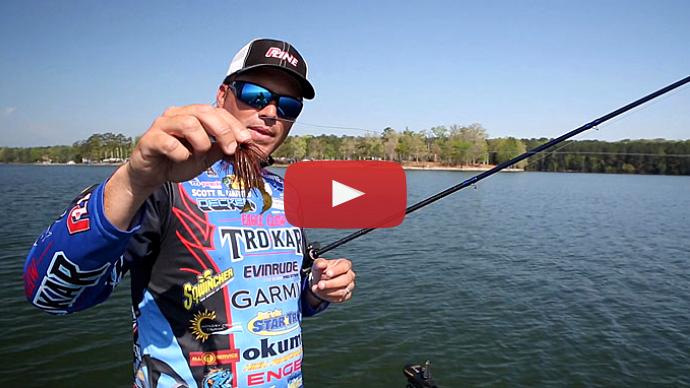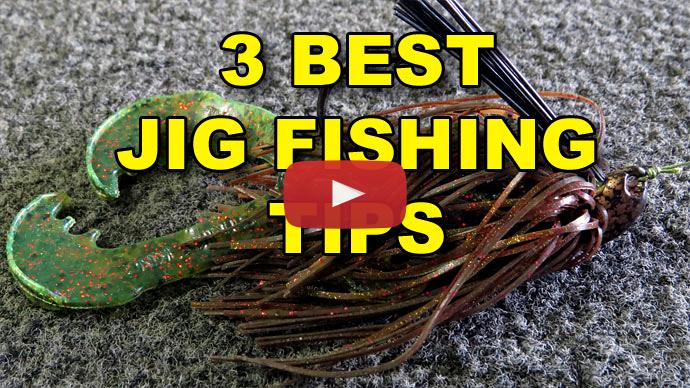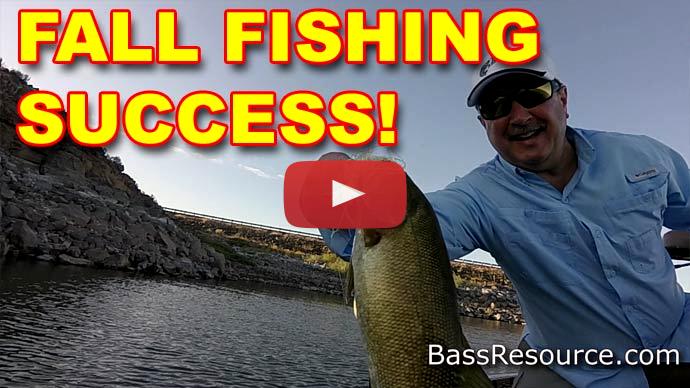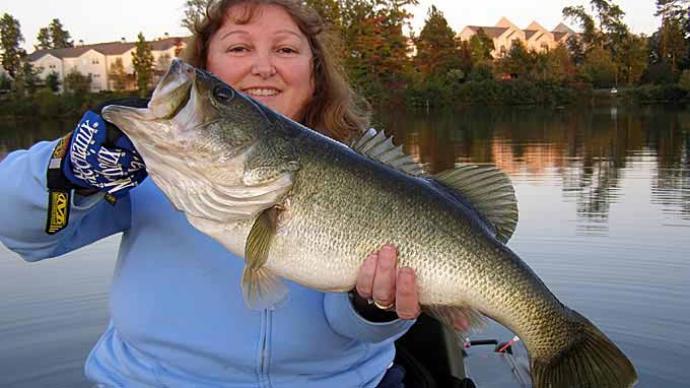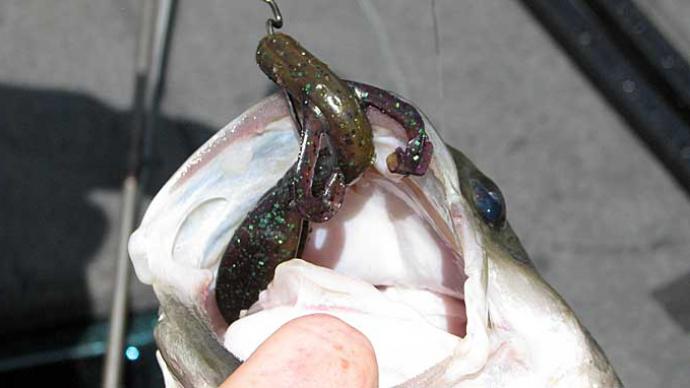Glenn: There we go. Nice.
Keri: Playing with that rock is what I was doing. I was like, "I know that rock has gotta hold fish." Easy does it, big guy. Easy does it. Gotcha. Yay.
Glenn: It's about catching fish with a jig.
Hey folks, Glenn May here with BassResource.com. Today I want to talk to you about fishing jigs in the fall. The bass are up feeding. They're eating a lot of baitfish and this little snack size, little Scooby Snack here is something just perfect when they're in that feeding mode. So I want to talk to you a little bit of how we can capitalize this time of year and catch the most fish with jigs during the fall.
First of all, what I want to talk about is kind of how I rig it. Here I'm using a little bit heavier gear. I'm using a medium-heavy rod. I'm using a bait casting outfit because I like to throw this in the heavier cover because they like to get up in that shallow water and they sit in that cover. So I'm using something a little bit heavier. I'm using a braided line, to begin with.
In the beginning of the fall, I kinda break it into two different seasons. The early fall and the late fall, I'll talk to you about that in just a second. So in the early fall, I'm using braid. This is a 50-pound Seaguar Smackdown braid. And then I'm using this...this is a 3/8 ounce jig with a football head jig on it. Okay? Very straightforward. I got more videos on jig fishing and it talks a little bit more about rigging but that's my setup. It's not a fast reel at all. It's just a strong drag on it.
So what I do with the fall is I break it into two different seasons. There's the early fall, which is from late summer until the water temps get into the mid-50s and then I have the late fall, which is the mid-50s down to lower 40s and then you're in the wintertime.
So on the first half of the season, first half of fall, that's when the fish are really up and moving fast. They're up and chasing baitfish. The baitfish are moving all around. They're moving up shallower. This is the perch, this is the shad. They're moving up shallower looking for that oxygen-rich water and the bass are following them. So they're not going to sit on one piece of structure for any amount of time. You got to look for them. You got to hunt and peck. You got to fish rather fast to try to find those packs of bass that are chasing schools of baitfish. So a jig can be a really effective tool to do that.
Basically what I do is I start, during this time of year, is I start on the outside of coves and pockets that have freshwater moving into them. Because freshwater brings in oxygen-rich water, which is what the baitfish are looking for.
So if a cove doesn't have freshwater flowing into it, then I will skip it and move to the next. It's not that there won't be baitfish in there but they'll just be more and greater concentrations of baitfish in the coves that do have freshwater and, of course, that's where the bass are going to be. I'm upping my chances that way.
So I start on the outside part of those coves fishing, any kind of structure I can find, be it a point, a main-lake point or a hump or a ridge or drop off, something like that. This is why I got a football head tied onto this because I'll throw it out there in that little bit of deeper water first. And also I want to do is bang along the bottom and lift it up and drop it, and lift it up and drop it or I'm reeling. That's a quick action.
I'm making as much commotion as I can because I want to call in any bass, actively feeding bass that are in the area. So it's not a real slow presentation. I'm actually bumping along, moving along pretty quickly.
If I don't get bit in those areas, then I'll start moving up shallow and work my way into that cove further and further. Anything you can see, any kind of cover that's worth throwing to, that's what I throw to. So laydowns, chunk rock, docks, any kind of weeds, that kind of stuff I like to throw to, any kind of timber, anything that the fish can relate to I throw to.
Now if at any time I hook onto a fish... This is what you got to do guys, you've got to slow down and fish that area thoroughly because again, there's pods of fish. They're you know, anywhere from 3 to 20 or 25 fish in a school of bass, they're roaming around and once you connect with them, there's more in that area. So you catch one, you can catch more if you slow down and work that area thoroughly. So if I was fishing that point, for example, if I caught a fish off it, I'd drop a marker buoy. And I criss-cross, different directions. Sometimes it's just a matter of coming from a different angle and you'll get more bites that way. So just milk that area until you can catch a bunch of fish out of it.
Now once that bite dies, you've got a choice. You can go one or two directions. One is, "Hey, that's a good piece of structure. You've caught a bunch of fish on it." So there's going to be another school coming along pretty soon that's going to utilize that piece of structure. You can hang on that. Just wait for the next school to come by. And it might be by 15, 20 minutes later and then boom, the bite picks up again, you're catching much more fish. It's a risk because you may end up waiting a long time, maybe a while before the next school comes along and you may not get as many.
So your other choice is to pick up stakes and speed up again and start covering more water and throw to more cover and structure and you might connect with another school that way.
There's two different ways of doing it. I fished it both ways. I've been successful both ways. It's just sort of a game-time decision that you have to make to see what kind of feels right.
If you get a real good, juicy piece of structure and you've caught a whole bunch of fish on it, that's probably going to be used again by another school. So I might hang around in there for a while, see if another school comes to by.
Glenn: There we go.
Keri: Oh, we got a fish. We have a smally or largey?
Glenn: We got a largemouth.
Keri: We got a largemouth. It's a nice largemouth too.
Glenn: There we go.
Keri: It's a nice fatty.
Glenn: Look at that.
Keri: Look at the light color.
Glenn: Well, he's cold.
Keri: I bet he is cold.
Glenn: Now, if I fished all those areas in that cove and I haven't caught any fish, then I'll pull off to the creek channel, right off the creek channel in the middle of the cove. And when I'm looking for there are bends in the creek channel where it swings in closer to the shore or where it connects with say a sandbar or a point, something like that, where it's got that close access to shallow water but that deep water is right nearby. And I'll target that.
Specifically, I'll target the inside bends of those channel bends. So if it bends like this, then this part out here, over here is the outside bend. This is where it curves like this. It will be a steeper drop here. On this inside bend on this side where it curves around, this is a shallower tapering area and that's what I'll target. That's slower moving current. Often you'll find cover in there, like chunk rock or blowdowns or you'll find weed patches and that's where you'll find the baitfish and, of course, the bass will be there too.
So I'll work in those areas and target, they can be really good hotspots. If I don't catch anything there, I go down to the next channel bend. I don't really work the area where it's straight. And you don't seem to catch as many fish in those stretches so just find the next creek bend and fish that.
Glenn There we go. Nice. All right. Get him, Kerry. You get him.
Keri: There is one particular spot out there and you have to be spot on it to do it. One spot.
Glenn: That's how you do those deeper jigs, is deeper fishing. That's a good, healthy fish.
Keri: That's a healthy fish. Oh yeah, I had him that time. You aren't going nowhere. Look at that.
Glenn: Nicely done.
Keri: Deep fishing. Woohoo.
Glenn: So that's kinda how I attack late summer into mid-fall. Now for mid-fall going into winter, early winter, the fish are now moving out. The weeds are dying off. The weeds will consume oxygen when they're dying. And like I said before, the baitfish are looking for oxygen-rich water so they won't be in those...the areas where there's dying weeds. Instead, they'll move out to the deeper weed lines. Look for that in 10, 15 to 25 feet of water, that last standing strands of green weeds, that's where you'll find the perch and the shad and the other baitfish in there and, of course, that's where the bass will be.
So I like to use this jig and just throw it out there on the outside weed line and just kind of pump it along. I just bounce it along. I like to lift it up pretty high and let it flutter back down on those areas because a fish will come right out and nab it and bite it.
If I don't get bit doing it that way, then I'll slow it down and I'll drag a little bit more but typically you can get bit on those outside weed lines during that time of year. And gradually work your way on out to deeper water.
Now we're going to the main lake. We're fishing main lake points. We're fishing rock piles. We're fishing humps, ditches, ledges, anything like that. This is where the football, the head comes in use here because it doesn't get hung up as much in those rocky areas.
And I like to just crawl it in. I don't lift it up as much. I'm lifting up very slightly, just a little bit and let it fall back down. Especially if I got the boat positioned on the outside, the deep part of that water, and I'm working on throwing up shallow because what happens is you've got this slope, the bait is here, you lift it up, it's going to swing out towards you and come way back down.
So you don't have to lift up much to make that swing on a steeper drops where the fish could be hanging. So I only lift it up 3, 4 inches and let it swing back down and fall. I don't want big, huge movements when the water is cold or like that, the fish aren't going to chase it as much.
Glenn: Here we are. Boom. Nice. Nice, nice, nice.
Keri: Not a giant guy but I'll take him.
Glenn: Jig fish.
Keri: Jig fish. Not giant but he wanted it and I got it. Little guy.
Glenn: Another way of fishing those areas is, especially you're getting closer into winter, early winter is I'll position the boat up shallow. I'll cast off into deeper water and then here I'm just slowly...I'm just cranking it real slow. I just crank it slow, slow, slow like this, right? I just want to work it on up the hill, up that point. Nice and slow and slow, just bumping it along. It looks kinda like a crawdad just bumping along the bottom. There's not too many crawdads that are left during that time of year. They're all looking to get...you know, had to hibernate and dig deep in that mud. So if there's any that are still out there, the bass are going to attack it. So this is a great way to catch those remaining active bass this time of year is just crawling it uphill, up those points and humps and ridges.
And a lot of times, unless you're fishing from the bank, the fish aren't used to seeing that type of presentation. So a lot of them will bite it that way. So it's a great way to fish going into the wintertime.
And then finally, the water temperature is below 50 what I like to do is I take the jig and I'll throw it out in those deeper structure areas and then I'll just drag it. I just throw it out there and I just hold the rod out to the side and I use the trolling motor or a slight breeze to kind of push the boat along and I'm just letting it bounce and crawl slowly over that structure. And a lot of times you'll get bit doing that. You've got to really pay close attention to your line and be in tune with what's going on under the water because those bites are very, very subtle.
If it was really rocky, I'll use fluorocarbon line instead of braid because rock can chew up the braid line. So I'll use something like 15-pound fluorocarbon line like Seaguars InvizX Fluorocarbon line is real abrasion-resistant. It works really well in that rocky area. I don't need anything stronger than that because there's nothing there for them to get wrapped around. It's just an open area. It's just a rocky open bottom. So a 15 pound InvizX works really well in those situations and just kind of bounce along the bottom and you can catch a lot of fish that way going into winter.
So that's the different ways I fish with jig and where I fish it during the fall. I hope that helps. For more tips and tricks like this, visit BassResource.com.

